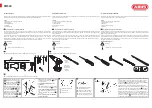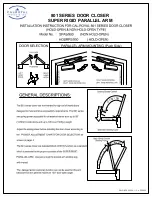
Page 13 of 20
1910308-12
1. POWER SWITCH
The power switch supplies electrical current to
the welder. Whenever the power switch is in the
ON position, the welding circuit is activated.
ALWAYS turn the power switch to the OFF
position and unplug the welder before
performing any maintenance.
2. VOLTAGE SELECTOR
The voltage selector controls the welding
voltage/heat. This unit has a voltage control
that is infinitely adjustable within its range.
Refer to the label inside the welder side door
for recommended voltage selector settings for
your welding job.
3. WIRE SPEED CONTROL
The wire speed control adjusts the speed at
which the wire is fed out of the welding torch.
The wire speed needs to be closely matched
(tuned-in) to the rate at which it is being melted
off. Some things that affect wire speed
selection are the type and diameter of the wire
being used, the heat setting selected, and the
welding position being used. Refer to the label
inside the welder side door for recommended
wire speed settings for your welding job.
NOTE:
The wire will feed faster without an arc.
When an arc is being drawn, the wire speed will
slow down.
4. HOLDING THE TORCH
The best way to hold the welding torch is the
way it feels most comfortable to you. While
practicing with your new welder, experiment by
holding the torch in different positions until you
find the one that seems to work best for you.
5. POSITION OF THE TORCH TO THE WORK
PIECE
There are two angles of the torch nozzle in
relation to the work piece that must be
considered when welding.
5.1. Angle can vary, but in most cases the
optimum angle will be 60 degrees, the
point at which the torch angle is parallel to
the work piece. If angle A is increased,
penetration will increase. If angle A is
decreased, penetration will decrease also.
5.2. Angle B can be varied for two reasons:
to improve the availability to see the arc in
relation to the weld puddle and to direct
the force of the arc.
6. DISTANCE FROM THE WORK PIECE - If
the nozzle is held off the work piece, the
distance between the nozzle and the work
piece should be kept constant and should not
exceed 1/4 inch or the arc may begin
sputtering, signaling a loss in welding
performance.
7. TUNING IN THE WIRE SPEED - This is one
of the most important parts of wire welder
operation and must be done before starting
each welding job or whenever the voltage
setting, or wire diameter is changed.
EXPOSURE TO A WELDING ARC IS
EXTREMELY HARMFUL TO THE EYES AND
SKIN! Prolonged exposure to the welding
arc can cause blindness and burns. Never
strike an arc or begin welding until you are
adequately protected. Wear flame-proof
welding gloves, a heavy long-sleeved shirt,
trousers without cuffs, high topped shoes,
and an ANSI approved welding helmet.
7.1 Connect the Ground Clamp to a scrap
piece of the same type of material which






































